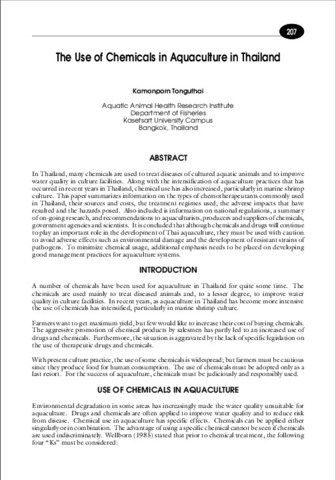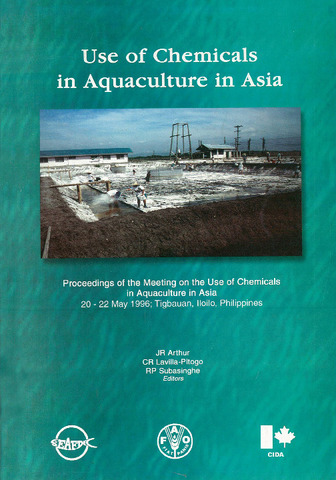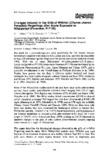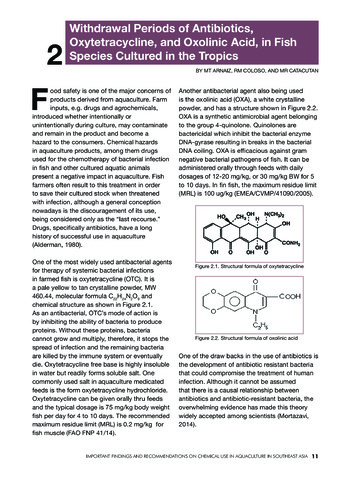The use of chemicals in aquaculture in Thailand
Share
Abstract
In Thailand, many chemicals are used to treat diseases of cultured aquatic animals and to improve water quality in culture facilities. Along with the intensification of aquaculture practices that has occurred in recent years in Thailand, chemical use has also increased, particularly in marine shrimp culture. This paper summarizes information on the types of chemotherapeutants commonly used in Thailand, their sources and costs, the treatment regimes used, the adverse impacts that have resulted and the hazards posed. Also included is information on national regulations, a summary of on-going research, and recommendations to aquaculturists, producers and suppliers of chemicals, government agencies and scientists. It is concluded that although chemicals and drugs will continue to play an important role in the development of Thai aquaculture, they must be used with caution to avoid adverse effects such as environmental damage and the development of resistant strains of pathogens. To minimize chemical usage, additional emphasis needs to be placed on developing good management practices for aquaculture systems.
Suggested Citation
Tonguthai, K. (2000). The use of chemicals in aquaculture in Thailand. In J. R. Arthur, C. R. Lavilla-Pitogo, & R. P. Subasinghe (Eds.), Use of Chemicals in Aquaculture in Asia: Proceedings of the Meeting on the Use of Chemicals in Aquaculture in Asia, 20-22 May 1996, Tigbauan, Iloilo, Philippines (pp. 207-220). Tigbauan, Iloilo, Philippines: Aquaculture Department, Southeast Asian Fisheries Development Center.
Subject
aquaculturists  ; drug resistance
; drug resistance  ; chlorine
; chlorine  ; antibiotics
; antibiotics  ; zeolites
; zeolites  ; aquaculture
; aquaculture  ; hormones
; hormones  ; feed composition
; feed composition  ; fertilizers
; fertilizers  ; disinfectants
; disinfectants  ; insecticides
; insecticides  ; aquatic drugs
; aquatic drugs  ; vitamins
; vitamins  ; iodine
; iodine  ; drugs
; drugs  ; fish culture
; fish culture  ; policies
; policies  ; shrimp culture
; shrimp culture  ; husbandry diseases
; husbandry diseases  ; environmental impact
; environmental impact  ; saponins
; saponins  ; aquaculture systems
; aquaculture systems  ; Control resistance; Intensive culture; aquaculture development
; Control resistance; Intensive culture; aquaculture development  ; dyes
; dyes  ; dolomite
; dolomite  ; Marine aquaculture; vaccines
; Marine aquaculture; vaccines  ; Penaeidae; Thailand; hatcheries
; Penaeidae; Thailand; hatcheries 
 ; drug resistance
; drug resistance  ; chlorine
; chlorine  ; antibiotics
; antibiotics  ; zeolites
; zeolites  ; aquaculture
; aquaculture  ; hormones
; hormones  ; feed composition
; feed composition  ; fertilizers
; fertilizers  ; disinfectants
; disinfectants  ; insecticides
; insecticides  ; aquatic drugs
; aquatic drugs  ; vitamins
; vitamins  ; iodine
; iodine  ; drugs
; drugs  ; fish culture
; fish culture  ; policies
; policies  ; shrimp culture
; shrimp culture  ; husbandry diseases
; husbandry diseases  ; environmental impact
; environmental impact  ; saponins
; saponins  ; aquaculture systems
; aquaculture systems  ; Control resistance; Intensive culture; aquaculture development
; Control resistance; Intensive culture; aquaculture development  ; dyes
; dyes  ; dolomite
; dolomite  ; Marine aquaculture; vaccines
; Marine aquaculture; vaccines  ; Penaeidae; Thailand; hatcheries
; Penaeidae; Thailand; hatcheries 
Collections
Related items
Showing items related by title, author, creator and subject.
-
Use of Chemicals in Aquaculture in Asia: Proceedings of the Meeting on the Use of Chemicals in Aquaculture in Asia, 20-22 May 1996, Tigbauan, Iloilo, Philippines
Arthur, J. Richard; Lavilla-Pitogo, Celia R.; Subasinghe, Rohana P. (Aquaculture Department, Southeast Asian Fisheries Development Center, 2000)The use of chemicals is common in various aquaculture systems, as it is in many agricultural practices. However, with growing worldwide awareness of the need for responsible practices in aquaculture, governments and ... -
Changes induced in the gills of milkfish (Chanos chanos Forsskål) fingerlings after acute exposure to nifurpirinol (Furanace; P-7138)
Tamse, Catherine T.; Gacutan, Rogelio Q.; Tamse, Armando F. (Springer Verlag, 1995)The need for a chemotherapeutant used specifically for fish disease became increasingly apparent with intensive fish culture practices, and with the possibility of bacterial resistance against drugs used for human and ... -
Withdrawal periods of antibiotics, oxytetracycline, and oxolinic acid, in fish species cultured in the tropics
Arnaiz, Margarita T.; Coloso, Relicardo M.; Catacutan, Mae R. (Aquaculture Department, Southeast Asian Fisheries Development Center, 2015)Food safety is one of the major concerns of products derived from aquaculture. Farm inputs, e.g. drugs and agrochemicals, introduced whether intentionally or unintentionally during culture, may contaminate and remain in ...




